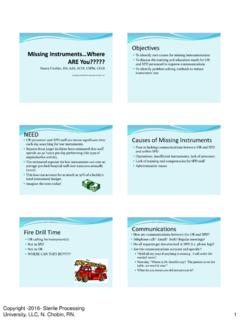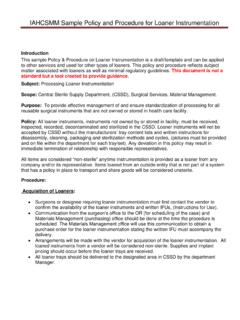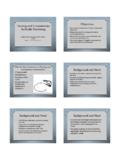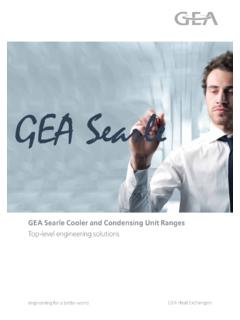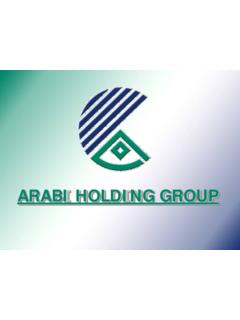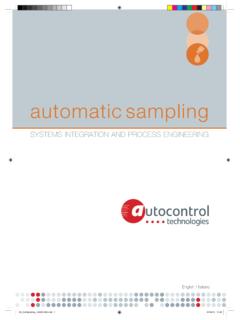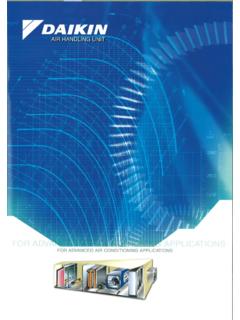Transcription of Ethylene Oxide Sterilization - NJHCSA Upcoming …
1 Ethylene Oxide Sterilization Continuing Education Contact Hours Participants must complete the entire presentation/seminar to achieve successful completion and receive contact hour credit. Partial credit will notbe given. All of the presenters are employees of STERIS Corporation and receive no direct compensation other than their normal salaries for participation in this activity. STERIS Corporation is an approved provider of continuing nursing education by the California Board of Registered Nursing, provider number CEP 11681 for 1 contact hour along with IAHCSMM and CBSPD. STERIS Corporation is providing the speakers and contact hours for this activity. However, products referred to or seen during this presentation do not constitute a commercial support by the completion of this course, you will be able to:Describe Ethylene Oxide (EO) as a low temperature method of sterilizationReview recommended procedures when performing EO sterilizationWhat is Ethylene Oxide ?
2 C2H4O Colorless gas Smells like ether Sporicidal Non-corrosive Readily permeates Small percentage used in healthcare to sterilize heat and Ethylene Oxide molecule and moisture sensitive devicesHistorical Perspective1859EO discovered(fumigation)1929EO/CO2patented for insecticide and microbial properties1930 Fumigant for spices, gums, cereals1950100% EO used for heat sensitive medical devices1949EO identified as a sterilant (Ft. Detrick)1960 sEO blends available1940100% EO patented as agricultural fumigant1980 sSafety issues surface(OSHA)To d a y100% EO1990 sEnvironmental issuesAdvantages Effective at low temperature/low moisture levels Excellent penetration with no lumen restrictions Widely accepted by device manufacturers Material compatibility Non-corrosive Relatively low capital equipment cost Effective on a wide range of microorganismsLimitations Long cycle times with aeration Expensive installation requirements EtOmonitoring required Toxicity Known health hazard and carcinogen to humans Installation requirements: dedicated exhaust, disposer, etc.
3 Refer to AAMI ST 41 Ethylene Oxide (EO) Kills by alkylation Combines with genetic material in cell, destroys ability to metabolize and reproduce Effects: irreversible, causes cell death Used in industry and hospitals Mixed blends now outlawed Single-use cartridges Reduced flammability Increased productivity and cost savings Safety features minimize operator exposure100% EOEO Sterilizer Key ComponentsCycle Selector Touch Pads & DisplayGasketSingle-use CartridgeImpact PrinterEnvirogardIn Chamber Aeration5 Cubic Foot Chamber100% EO Increased productivity and cost savings Higher concentration of EO Not paying for expensive inert gases Safety features minimizes operator exposure: In chamber placement Vacuum cycles In chamber aeration Chamber operates under negative pressure100% EO Sterilization Phases Preconditioning Conditioning Exposure Exhaust AerationEO Sterilization Parameters EO gas concentration 740-100 mg/L Relative humidity 40-80% (critical to penetration of bacterial cells and successful Sterilization ) Temperature High 145 F (63 C) Low 98 F (37 C) Exposure Varies between 1-6 hoursPreconditioning Chamber is sealed Vacuum is pulled Chamber begins to heat devices to preselected temperature (usually 100 or 130 F)Conditioning Humidification steam in Vacuum pulls and moisture purges Humidity at preset range EO sterilant and pressure risesExposure Sterilization 1 hour at 130 F hours at 100 F Chamber maintained at selected.
4 EO concentration Temperature Humidity For prescribed timeExhaust Vacuum is drawn Filtered air wash AerationAeration Requirements Removes residual EO before use or storage Device manufacturer provides parameters Single-chamber process required Sterilization and aeration must occur in the same chamber 12 hours at 130 F ( C) 36 hours at 100 F ( C) The load cannot be physically moved until aeration is completeWhat Happens to Aerator Exhaust? Most Common Non-recirculating Dedicated exhaust to atmosphere Clean Air Act of 1990 EPA regulates EO Some states require emission control systems to treat aerator exhaustEO Must Be Used With Care Known human carcinogen Improper use hazard Acute exposure Irritation, CNS depression Chronic inhalation Cataracts, cognitive impairment, neurologic dysfunction Occupational exposure Hematologic changes.
5 Some cancers EPA EtONational Emission StandardsMarch 2008 Sterilize full loads Demonstrate and submit compliance status with management practice standardRecord keeping Compliance status Sterilizers not equipped with air pollution control devicesMarch 2010 Single chamber process no separate chamberPreparing Devices for EtOFollow manufacturer IFUs Cleaning/decontamination Packaging/loading/unloading Aeration Items Must Be Clean And Dry! H2O + EO = Ethylene GlycolPackaging Materials Must be validated Allows penetration Removal during aeration Withstands rapid air removal during vacuum Withstands normal handling Economical Readily availablePackaging Materials Natural or synthetic woven textiles Non-woven, disposable, flat wrappers Polypropylene, cellulose fibers, cellulose-polyester Plastic/paper peel pouches Tyvek Rigid containers Limit use of absorbent surgical towels in setsInappropriate Packaging Materials Nylon/Teflon PVC (Saran Wrap)
6 Mylar Cellophane Aluminum foilAccessoriesLoading Peel Pouches Verify package integrity Place peel pouches on edge Arrange plastic to paper Use perforated, wire mesh bottom traysLoading Carts or Baskets Use metal baskets only Load in loose fashion No contact with walls of chamber Load to avoid contact if transferring for aerationAeration Removes toxic EO residues Same temperature as Sterilization Series of pulses introduced, vacuum pulled, cycle repeated Factors determining aeration time Sterilization /aeration system used Wrapping materials/containers Design/weight of devices Size/arrangements of packsWhy is Aeration Essential? With premature removal, EO exposure can occur Adverse health effects through long term exposure ambient air aeration is not recommended No one is off the hook by signing a waiverQuality Assurance Physical monitors Chemical indicators Biological indicators Environmental monitors Chemical Indicators Indicator of sterilantconditions present External indicators Internal indicators Placed in most challenging area for sterilantpenetrationBiological Indicators Sterilization verification Bacillus atrophaeus(subtilis)
7 Control biological Follow BI manufacturer instructions Routine monitoring Test EVERY Sterilization cycle Installation Testing Verification of sterilizer efficacy After installation of new Sterilization After major repairs Relocation Unexplained sterility failure Change in gas supply, chamber load patterns Three consecutive cycles negative results Utilize challenge pack (AAMI ST 41)Record Keeping Load record Cycle documentation Chemical and biological indicator results Preventive maintenance/service records Records kept according to state and local statutes Sterilization malfunction Remove sterilizer from service Determine sterility of loadOccupational Exposure Limits Occupational Safety Health Administration (OSHA) Established limits, 1984 Updated limits, 1987 Limits at breathing zone of workerOccupational Exposure Limits Time Weighted Average (TWA) Average personnel exposure during specific period of time Permissible Exposure Limit (PEL) Maximum EO exposure allowed in 8 hours 1 ppm EO is the 8 hour TWA Code of Federal Regulations (CFR)(Section 1910, Subpart Z, Toxic and Hazardous Substances)Occupational Exposure Limits Action Level AL EO exposure level above which OSHA requirements apply ppm is 8 hour TWA Excursion Limit EL OSHA term to define short-term exposure limit 5 ppm is 15 minute TWAE nvironmental MonitorsArea monitoringPersonnel monitoringAction ItemYour policy and procedures should be in-line with recommended standards (AAMI ST 41/EPA National Emission Standards).
8 Also, ensure your team understands the policy and procedures. This will ensure your facility s compliance and safe practice. References Association for the Advancement of Medical Instrumentation, Ethylene Oxide Sterilization in Healthcare Facilities: Safety & Effectiveness AAMI ST41:2008 Arlington, VA Association of periOperative Registered Nurses, Recommended Practice for Sterilization in the Practice Setting, Denver, CO, 2010, AORN International Association of Healthcare Central Service Materiel Management, (IAHCSMM) Central Service Technical Manual, Chicago, IL, 2007 Occupational Safety and Health Administration, (OSHA), Occupational Exposure to Ethylene Oxide , Final Standard (29 CFR ) Ball, KA, Endoscopic Surgery, St. Louis, MO, 1997, CV Mosby, Inc. Reichert, M and Young, J, Sterilization Technology for the Health Care Facility, Gaithersburg, MD, 1997, Aspen Publishers, Inc.
9 United States Environmental Protection Agency (EPA), Re-registration Eligibility Decision for Ethylene Oxide , March 31, 2008 QuestionsGo to: a part in your professional development today To help you achieve your career vision for tomorrowEthylene Oxide AAMI/ANSI 41 Devices are clean and dry ETO is sensitive to the presence of residual soil Low pressure (vacuum) systems Venting cap required Sterilization parameters validated by endoscope manufacturer Conditioning, Sterilization and aeration Post- Sterilization aeration is essential Processing time typically >18 hours May have a limited number of cycles before requiring extensive repair

